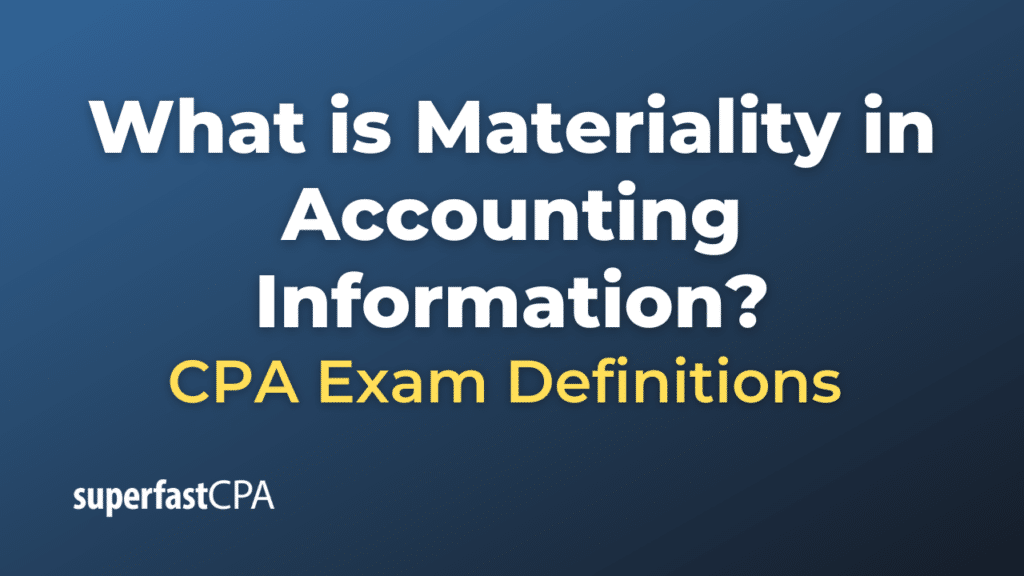Materiality in Accounting Information
Materiality in accounting refers to the significance of an accounting information item in the context of financial statements or accounting records. In other words, if the inclusion or omission of a particular piece of information would influence the economic decisions of the users of financial statements, then that information is considered material. This concept is important for accountants, auditors, and financial statement users because it helps determine what information must be disclosed.
Materiality is a subjective concept, and there is no hard and fast rule for determining what constitutes a material amount. Usually, accountants and auditors use a combination of quantitative and qualitative factors to assess materiality. For example:
- Quantitative Factors: These are numerical and can include guidelines like a certain percentage of net income or total assets. If a transaction or error is larger than the defined percentage, it may be considered material.
- Qualitative Factors: These are non-numerical and relate to the nature of the item or error. Factors could include whether the omission or misstatement would affect compliance with regulatory requirements, or whether it would hide a change in earnings.
The concept of materiality is fundamental to the process of preparing and auditing financial statements for several reasons:
- Resource Allocation: Given that resources are limited, focusing on material items allows both preparers and auditors to allocate their efforts efficiently.
- Reliability and Relevance: Ensuring that material information is accurately presented helps make the financial statements more reliable and relevant to stakeholders.
- Comparability: The materiality principle helps to ensure that financial statements are comparable over different accounting periods and among different companies, as immaterial items are less likely to cause variations.
- Disclosure: Companies need to disclose material items in the notes to the financial statements. This helps in providing a full picture of a company’s financial health to the stakeholders.
- Legal and Regulatory Compliance: Misstating material items could result in legal consequences, including fines and loss of investor trust.
- Audit Quality: For auditors, materiality helps in planning the audit and evaluating the impact of identified misstatements on the financial statements.
In summary, materiality in accounting helps in the presentation of a true and fair view of financial statements by identifying which transactions and balances are significant enough to warrant careful treatment and disclosure.
Example of Materiality in Accounting Information
Let’s consider a simple example to illustrate the concept of materiality in accounting:
Scenario
Suppose a company named “TechMart” has annual revenues of $10 million, and it discovers an accounting error that resulted in underreporting expenses by $5,000 for the year.
Quantitative Assessment
- As a percentage of annual revenues, the $5,000 error is 0.05% ($5,000 / $10,000,000 x 100).
- Let’s assume the company, based on industry standards and its internal guidelines, has set a materiality threshold at 0.1% of annual revenues.
In this example, the $5,000 error is below the company’s quantitative materiality threshold of 0.1%. Therefore, it might be considered immaterial from a purely numerical standpoint.
Qualitative Assessment
However, the materiality of the error should also be evaluated based on qualitative factors:
- Is the error related to an area of the business that is under regulatory scrutiny? If yes, then even a small error might be considered material.
- Does the error affect key performance indicators that investors pay close attention to? If so, it may be material even if the monetary amount is small.
- Does the error hide a trend of declining profitability or other key metric? If so, then its significance increases.
Decision
After considering both quantitative and qualitative factors, TechMart decides that the $5,000 error is immaterial for its financial statements based on its internal guidelines and the absence of significant qualitative factors that would make the error material.
As a result, TechMart may decide not to adjust its financial statements for the $5,000 error but could choose to correct it in the next accounting period.
Summary
This example illustrates how both quantitative and qualitative factors are used in determining materiality in accounting. Even though the $5,000 error was not quantitatively material based on the company’s preset thresholds, it would still have needed to be evaluated for materiality using qualitative factors. Companies often need to use judgment in these matters to present a true and fair view of their financial position and performance.













